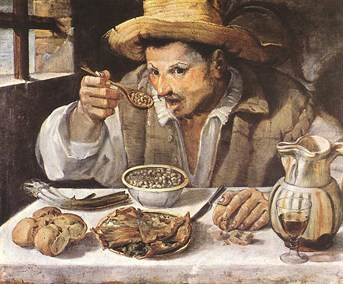Slow changes
 The eating habits of Europeans certainly changed as a result of the discovery of the Americas and foods imported from there. However, foods such as tomatoes, potatoes or corn finally entered the diet of the West after a long process, and finally only from the nineteenth century onwards. Other products instead spread more rapidly: new drinks such as coffee, tea and chocolate, and exotic products and animals like chili and turkey, or others which were already well-known in Europe but their production increased considerably since the sixteenth century onwards, as in the case of sugar.
The eating habits of Europeans certainly changed as a result of the discovery of the Americas and foods imported from there. However, foods such as tomatoes, potatoes or corn finally entered the diet of the West after a long process, and finally only from the nineteenth century onwards. Other products instead spread more rapidly: new drinks such as coffee, tea and chocolate, and exotic products and animals like chili and turkey, or others which were already well-known in Europe but their production increased considerably since the sixteenth century onwards, as in the case of sugar.
Within the European continent, the differences in eating habits from region to region, however, were considerable, caused by various factors. The Protestant Reformation had already contributed to the breakdown of the unity of European cuisine, favouring the emergence of different local cuisines. The expansion of the city favoured the shift from subsistence agriculture to market agriculture, the demographic development in the sixteenth and then in the eighteenth century was responsible for the extension of land allocated to cereals, while the greater wealth of the countries of Northern Europe may partly explain the increased production and higher consumption of alcohol. An important role in the nutrition of European populations was played by the more general social and economic transformations: the appearance of enclosures in England and the progressive concentration of land ownership at the European level in the hands of a few had obvious repercussions in the eating and drinking of the continental population. From another point of view, the increasing spread of printing facilitated the drafting and circulation of books on food, cookbooks and treatises on proper “dining” that contributed greatly to the definition of the different national cuisines. (image: Annibale Carracci, Il mangiafagioli).
